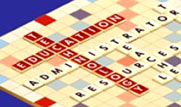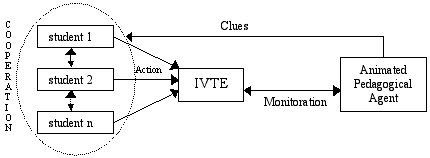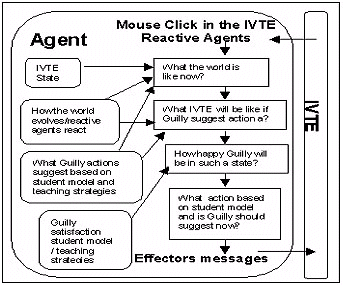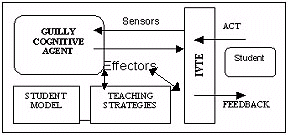
 |
| [ ASET ]
[ Proceedings Contents ] |
This paper describes an educational game for distance learning called IVTE - Intelligent Virtual Teaching Environment. The IVTE game is being developed for children aged from 8 to 10 to make them aware of urban garbage correct selection. The IVTE will allow the children to navigate and will insert them in a microworld that will be able to carry out activities inside the environment and verify how successful they have been in correct selection of garbage by using a monitor tutor. This tutor is an Animated Pedagogical Agent called Guilly, which will guide the student select adequate plans and strategies. This adequate plans and strategies are selected in accordance with student actions in the environment while selecting all kinds of garbage produced day by day. The IVTE game is considered an Intelligent Tutoring System. This technology is relevant to Education because it gives adaptable information to student during his interaction. The Animated Pedagogical Agent in the IVTE game supports this type of information. Guilly monitors students, gives face-to-face feedback when it is necessary considering students' difficulties. It makes the teaching adaptable to each student by use of student model and teaching strategies. Technologies like Distance Learning and Animated Pedagogical Agents will be described in this paper. Finally, this paper comments on how this environment is by using this technologies.
According to Lane (1998, p. 93), the term "Distance Learning" refers to teaching and learning situations in which the instructor and learners are geographically separated, and therefore, rely on electronic devices and print material for instructional delivery. The communication between student and teacher is supported by computational resources.
Recently, the concept of Artificial Intelligence is being added to computational resource. It will contribute significantly to the teaching-learning process. These features are being applied to the modelling and creation of Intelligence Tutoring System (ITS) for Distance Learning.
The development of ITS is an important step to improving the computer technology used in educational fields. The main aim of ITS is to reproduce an intelligent behaviour of a human teacher/tutor. This behaviour is used to adapt the way of teaching according to the student learning rhythm. Thus, an ITS should be clever enough to generate a teaching plan based on student features, knowledge and environment necessity, It must also be capable of remaking a teaching plan if necessary.
An ITS has a tutor, the personification of tutor can be done by using an Animated Pedagogical Agent. According to Shaw (1999), Animated Pedagogical Agents are lifelike animated characters that facilitate the learning process (p1).
This paper presents the application of Distance Learning Concepts and Animated Pedagogical Agents in the modelling and development of the IVTE software. The IVTE is an environment to develop children's ecological character aged from 8 to 10 to make them aware of urban garbage correct selection or disposal.
The paper is organised as follows: section 2 describes the Distance Learning Technology; section 3 presents Animated Pedagogical Agent features; in section 4 the IVTE environment is presented; section 5 presents Guilly Architecture. Finally, the conclusion and future directions followed by References.
Distance Learning adds additional avenues to the education process as it enables the expansion of the Campus outreach. Through Distance Education, many people are taking courses who simply would not have enrolled for a traditional course because of their work, duties or distance circumstances. Distance Learning is still not a mainstream educational method, and few institutions have the knowledge and experience to successfully offer full programs in this format (Novitzki, 1998, p.60).
The Internet has brought a new dimension to this concept: distance learning now means the opportunity to mirror rather than merely supplement classroom experience using computer technology for health education promotion.
Educational Software with Distance Learning features by itself is not capable to feed a personalised learning. The application of Artificial Intelligence (AI) solves this problem. The Animated Pedagogical Agent is a new paradigm used in AI area, it gives a feedback to personalised learning.
An Educational Software implemented by using concepts of Distance Learning and Animated Pedagogical Agents gives features as follows: personalised learning, stimulus, motivation, knowledge construction, presentation of instruction material in attractive, creative way integrating student. These features allow quality gains from a pedagogical point of view reinforcing the teaching process.
Creating lifelike pedagogical agents potentially provides four important educational benefits: (Lester, 1997, p 2 )
An Animated Pedagogical agent represents a new paradigm that can be applied to Education. This paradigm is used in the learning process. Animated Pedagogical Agents represent the newest generation of Human-Computer Interface's design. They are different from Pedagogical Agent because their appearance is like an animated character. They offer a digital guide to the students through which they can lead the students to the same affectionate answers that are generated by the other natural feature categories. Motivation is a key ingredient for the learning process and emotions play an important role in it. Therefore, Pedagogical Agents are more likely to be more effective if they can show emotions.
An Animated Pedagogical Agent that is capable of expressing different emotions rather than demonstrate just the same reactions do different environment situations, makes us believe that It thinks and feels increasing its own credibility.
There is an enormous expectancy in relation to the Pedagogical Agent generates emotive answers in the interaction with the student. Emotive behaviour like facial and body expressions call the student attention motivating the student actions.
According to Lester (Lester, 1997, p6) a well-designed lifelike persona interacting with students using learning environments are perceived as being very helpful, credible and entertaining. The persona may be able to express attitudes and moods, demonstrate skills being learned, and use non-verbal cues to help focus the learner's attention.
Concerning Slater (Slater, 2000, para. 5) an Interactive Animated Pedagogical Agent consists of the following features:
As far as environmental conditions are concerned a small village is simulated as show in Figure 1. The context where the microworld is inserted represents actions taking place in the daily routine of Brazilian children.

Figure 1: IVTE Environment: Guilly Animated Pedagogical Agent, Meter and Localisation Map
The environment works in a non-immersive virtual reality context. The student action in the environment are taken through scenario elements like trees, houses, a lake, vendors, garbage representation and trash bins, like real life.
The software allows children to walk in different directions from their home to school. In fact, students come across many types of garbage found in the environment or produced by themselves during the interaction. The software also has an internal environment representing the student home. In the student home s/he also generates garbage and must select it accordingly.
The IVTE is an educational game designed for distance learning where several students may interact simultaneously in its environment. The idea of having two or more students using the same computer is not so interesting as promoting interaction among different machines either in the same room or in different continents. Being so, the Internet (Intranet) would be the communication media used by the students no matter where they are. The idea may represent an interesting concept considering the place where each student plays in his own computer.
The children may find their own positions by using the localisation map (Figure 1) and may interact with other children in the environment either to share opinions before decision-makings or organise discussion lists about bigger issues. This kind of interaction facilitates information exchange as well as creation of action strategy among the students and consequently, a better learning result is achieved. During this kind of student interaction there is no tutor intervention. Being so, the students must find solutions on their own to all the problems.
When students are navigating in the IVTE environment, an Animated Pedagogical Agent called Guilly (Figure 1) monitors them. Guilly gives students feedback through clues. These clues are conveyed to students by messages, body and facial expressions. The generic architecture of the IVTE environment is shown in Figure 2:

Figure 2: IVTE Environment Architecture
The agent's emotional state varies according to the student's behaviour in the environment at a certain moment and it is demonstrated through emotive facial and body expressions that show approval every time a student selects garbage correctly, state of alertness whenever there is need of immediate student attention and discomfort in case the student makes a mistake.
The IVTE environment is lucid, for this reason, the student performance is measured by the "Meter", according to figure 1. A tree represents the Meter, growing up or keeping it at same side. It depends on the student behaviour in the IVTE environment.
Additionally, there is another IVTE important feature: the Zoom tool. The Zoom is implicit in the IVTE environment, but it appears when the pedagogical agent asks or when student activates it. It is used to show the environmental impacts of the student's actions, in other words, the student can think about his/her actions in the environment. This procedure helps the student in the knowledge construction process.
Guilly's feedback to user is made by non-verbal or verbal communication. This feedback depends on the user knowledge about the Correct Selection of Urban Garbage. Guilly's messages are selected based on the student model and teaching strategies (Oliveira, 2000, p. 71).
In Figure 3, the Guilly Cognitive Agent Architecture is described according to Russell's model (Russell, 1995, p. 45).

Figure 3: Guilly Cognitive Agent Architecture
The next figure, Figure 4, presents the Generic Guilly Architecture.

Figure 4: Generic Guilly Architecture
Guilly receives IVTE environment information by sensors (it knows the user/student actions and the IVTE reactions shown by the Reactive Agents). In addition, Guilly searches for the specific student model from the student model base taking into consideration the students' actions during the game. When the student model is selected, Guilly searches for adequate teaching strategies tied to specific student model selected previously. Finally, Guilly gives feedback to student using the IVTE interface through messages as shown in Figure 3.
The Student Model Base stores information like percentage of marks and how many times the students have used specific garbage for selection. The Student Model Base is also based on student performance and game time. The Student Model is dynamic in the software, in other words, the student plays in the IVTE Software where he acts, through his/her actions. The agents on the IVTE Software select the correct Student Model from the Student Model Base. When the software initialise the Student Model, Optimal Student Model is activated. While the student acts in the IVTE Software, he is monitored. This monitoring verifies if it is necessary to change the Student Model. The Student Model changes according to student behaviour. Student behaviour is controlled by error percentage, game time, and number of times that the student selects the same garbage and number of times the student proceeds correctly with garbage. The IVTE Software interaction must be adjusted according to the selected Student Model.
The fundamental principle to guarantee pedagogical quality in a Teaching Environment is by using different Teaching Strategies. A Teaching Strategy is the way through which the Tutor helps student in his knowledge construction. A Teaching Strategy is defined as methods used to help student during the educational software interaction changing his cognitive stage.
In the IVTE Software, an Animated Pedagogical Agent will apply Teaching Strategies according to the selected Student Model. The IVTE Animated Pedagogical Agent selects the Teaching Strategy based on a student cognitive stage, his knowledge level and learning rhythm.
The presence of a lifelike agent may increase student motivation under the intelligent Educational Systems approach that uses verbal and non-verbal communication as a way of interacting in such systems. In the IVTE the students are monitored by a 2D animated Pedagogical Agent. As far as future works are concerned, a 3D Animated Pedagogical Agent modelling has been considered whose aim is to convey a larger illusion of life and therefore, turn the agent into an even more realistic element.
Johnson, W. L. (1998). Pedagogical agents. ICCE'98 - Proceedings Sixth International Conference on Computers in Education. China. http://www.isi.edu/isd/carte/ped_agents/pedagogical_agents.html [verified 20 Aug 2002]
Lane, C. and Portway, P. S. (1997). Guide to Teleconferencing and Distance Learning, p. 93.
Lester, J. C., Converse, S. A., Kahler, S. E., Barlow, S. T., Stone, B. A., Bhoga, R. S. (1997). The Persona Effect: Affective Impact of Animated Pedagogical Agents. CHI'97 - Conference on Human Factors in Computing Systems. ACM: Electronic Publication. http://www.acm.org/sigchi/chi97/proceedings/paper/jl.htm [verified 20 Aug 2002]
Novitzki, J. E. (1998). Web-based: Learning and Teaching Technologies: Opportunities and Challenges. p.60
Nunes, M. A. S. N., Dihl, L. L., Oliveira, L. C. de, Woszezenki, C. R., Fraga, L., Nogueira, C. R. D., Francisco, D. J., Machado, G. J. C., Notargiacomo, M. G. C. (2001). Reactive Agents in the IVTE Software Using Java 3D. In IMSA'2001- Internet and Multimedia Systems and Applications, Honolulu, Hawaii.
Oliveira, Lisiane Cézar de (2000). Uma Proposta de Modelagem de Aluno para o Ambiente AVEI- Ambiente Virtual de Ensino Inteligente. 2000. Trabalho de conclusão de curso (Ciencia da Computacao) -Universidade Regional Integrada do Alto Uruguai e das Missões, (Orientador) Maria Augusta Silveira Netto Nunes.
Russell, S. and Norvig, P. Artificial Intelligence: A Modern Approach. New Jersey: Prentice - Hall Series in Artificial Intelligence, 1995.
Shaw, E., Johnson, W. L., Ganeshan, R. (1997). Pedagogical Agents on the Web. ACM: Electronic Publication. http://www.isi.edu/isd/ADE/papers/agents99/agents99.htm [verified 20 Aug 2002]
Slater, D. (2000). Interactive Animated Pedagogical Agents: An introduction to an emerging field. ED324/G345: Stanford University. 2000. http://ldt.stanford.edu/~slater/pages/agents/ [verified 20 Aug 2002]
| Authors: Maria Augusta S. N. Nunes, Leandro L. Dihl, Luciane M. Fraga, Cristiane R. Woszezenki, Lisiane Oliveira, Deise J. Francisco, Glaucio J. C. Machado, Carmem R. D. Nogueira, Maria da Glória Notargiacomo
URI University - Universidade Regional Integrada Engineering and Computer Science Department, Santo Ângelo - RS - Brazil {guta, ldihl, fraga, cristianerw, dfrancis, gcmachado, crdn, gloria} @urisan.tche.br http://www.urisan.tche.br/~guta/ [verified 20 Aug 2002] Please cite as: Nunes, M.A., Dihl, L.L., Fraga, L.M., Woszezenki, C. R., Oliveira, L., Francisco, D. J., Machado, G., Nogueira, C. and Notargiacomo, M. (2002). IVTE - Pedagogical Game for distance learning. In S. McNamara and E. Stacey (Eds), Untangling the Web: Establishing Learning Links. Proceedings ASET Conference 2002. Melbourne, 7-10 July. http://www.aset.org.au/confs/2002/nunes.html |